Book contents
- Frontmatter
- Dedication
- Contents
- Preface
- Acknowledgments
- PART I VOICES FROM THE FIELD
- PART II VOICES FROM THE RESEARCH
- 5 Developing Creativity Across All Areas of the Curriculum
- 6 Accountability, the Common Core, and Creativity
- 7 Ever-Broadening Conceptions of Creativity in the Classroom
- 8 Creativity in Mathematics Teaching: A Chinese Perspective (An Update)
- 9 Roads Not Taken, New Roads to Take: Looking for Creativity in the Classroom
- 10 The Five Core Attitudes and Seven I's of the Creative Process
- 11 Creativity Embedded into K–12 Teacher Preparation and Beyond
- 12 Attitude Change as the Precursor to Creativity Enhancement
- 13 Nurturing Creativity in the Engineering Classroom
- 14 Intrinsic Motivation and Creativity in the Classroom: Have We Come Full Circle?
- 15 Learning for Creativity
- 16 Creativity and Prosocial Values: Nurturing Cooperation within the Classroom
- 17 How Social-Emotional Imagination Facilitates Deep Learning and Creativity in the Classroom
- 18 Four Faces of Creativity at School
- 19 Teaching for Creativity
- 20 A Coda for Creativity in the Classroom: Take-Home Points and Final Insights
- Index
- References
14 - Intrinsic Motivation and Creativity in the Classroom: Have We Come Full Circle?
from PART II - VOICES FROM THE RESEARCH
Published online by Cambridge University Press: 24 November 2016
- Frontmatter
- Dedication
- Contents
- Preface
- Acknowledgments
- PART I VOICES FROM THE FIELD
- PART II VOICES FROM THE RESEARCH
- 5 Developing Creativity Across All Areas of the Curriculum
- 6 Accountability, the Common Core, and Creativity
- 7 Ever-Broadening Conceptions of Creativity in the Classroom
- 8 Creativity in Mathematics Teaching: A Chinese Perspective (An Update)
- 9 Roads Not Taken, New Roads to Take: Looking for Creativity in the Classroom
- 10 The Five Core Attitudes and Seven I's of the Creative Process
- 11 Creativity Embedded into K–12 Teacher Preparation and Beyond
- 12 Attitude Change as the Precursor to Creativity Enhancement
- 13 Nurturing Creativity in the Engineering Classroom
- 14 Intrinsic Motivation and Creativity in the Classroom: Have We Come Full Circle?
- 15 Learning for Creativity
- 16 Creativity and Prosocial Values: Nurturing Cooperation within the Classroom
- 17 How Social-Emotional Imagination Facilitates Deep Learning and Creativity in the Classroom
- 18 Four Faces of Creativity at School
- 19 Teaching for Creativity
- 20 A Coda for Creativity in the Classroom: Take-Home Points and Final Insights
- Index
- References
Summary
As I organized my ideas in preparation for the writing of the original version of this chapter, I came to realize that my thinking and my research efforts had almost come full circle. Now, half a decade later, that circle is closer than ever before to becoming closed. Almost 35 years ago, I moved to Denver, Colorado, to begin my career as a fledgling teacher. My experiences in my mixed-age classroom filled with five-, six-, and seven-year-olds kindled within me a deep interest in motivation and creativity of performance. My concerns about what our educational system was not doing to promote student growth in these areas became so great that I eventually left my elementary classroom to return to school myself. I was convinced that it was the field of psychology, and more specifically the study of the social psychology of creativity, that could best provide the answers I was looking for. As a graduate student and later as a professor of psychology, I have been almost single-minded in my attempts to answer empirically the question of how best to structure classrooms so that they are most conducive to student motivation and creativity. Over the past 40 years, researchers in this area have contributed literally hundreds of investigations to the psychological and educational psychology literatures; for my own part, in the last few years, I have even been bold enough to end a few chapters or monographs with a “laundry list” of what teachers and school administrators should and should not do if student intrinsic motivation and creativity are the goal.
Our research has lead to the establishment of a number of models of the intersection between intrinsic motivation and creativity of performance (Amabile, 1996; Hennessey, 2003; Hennessey & Amabile, 1988), rubrics that are now widely accepted by investigators in the areas of social psychology and related specialties. The so-called Intrinsic Motivation Principle of Creativity (Amabile 1996; Hennessey, 2003) on which much of our work is based has even been the subject of heated professional debate (Eisenberger, 2003; Eisenberger, Armeli, & Pretz, 1998; Eisenberger & Cameron, 1996, 1998; Eisenberger, Pierce, & Cameron, 1999; Hennessey & Amabile, 1998). While initially disconcerting, I have come to see this argument as the sincerest form of flattery, as only established theories garner sufficient criticism and ire to be considered controversial.
- Type
- Chapter
- Information
- Nurturing Creativity in the Classroom , pp. 227 - 264Publisher: Cambridge University PressPrint publication year: 2016
References
- 5
- Cited by

